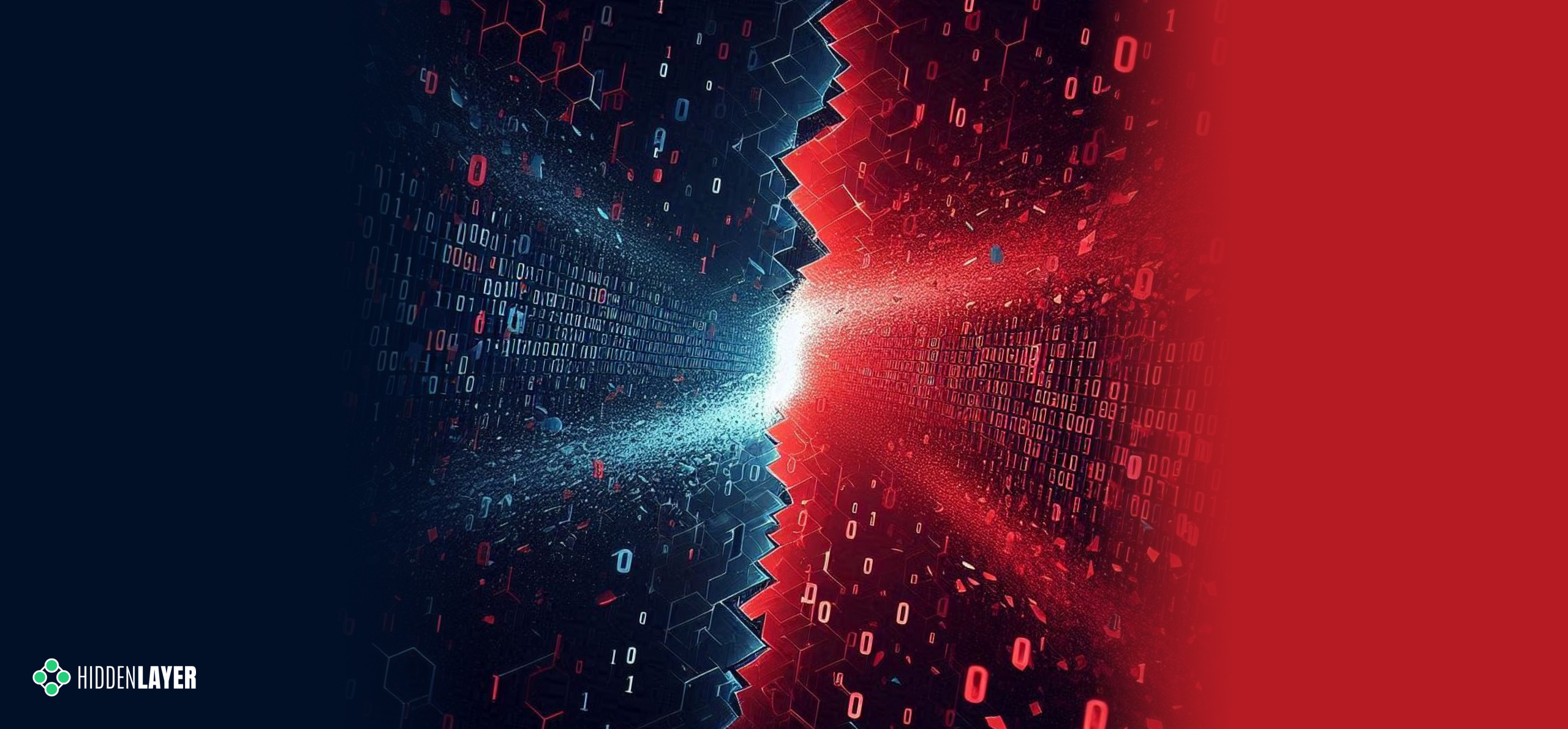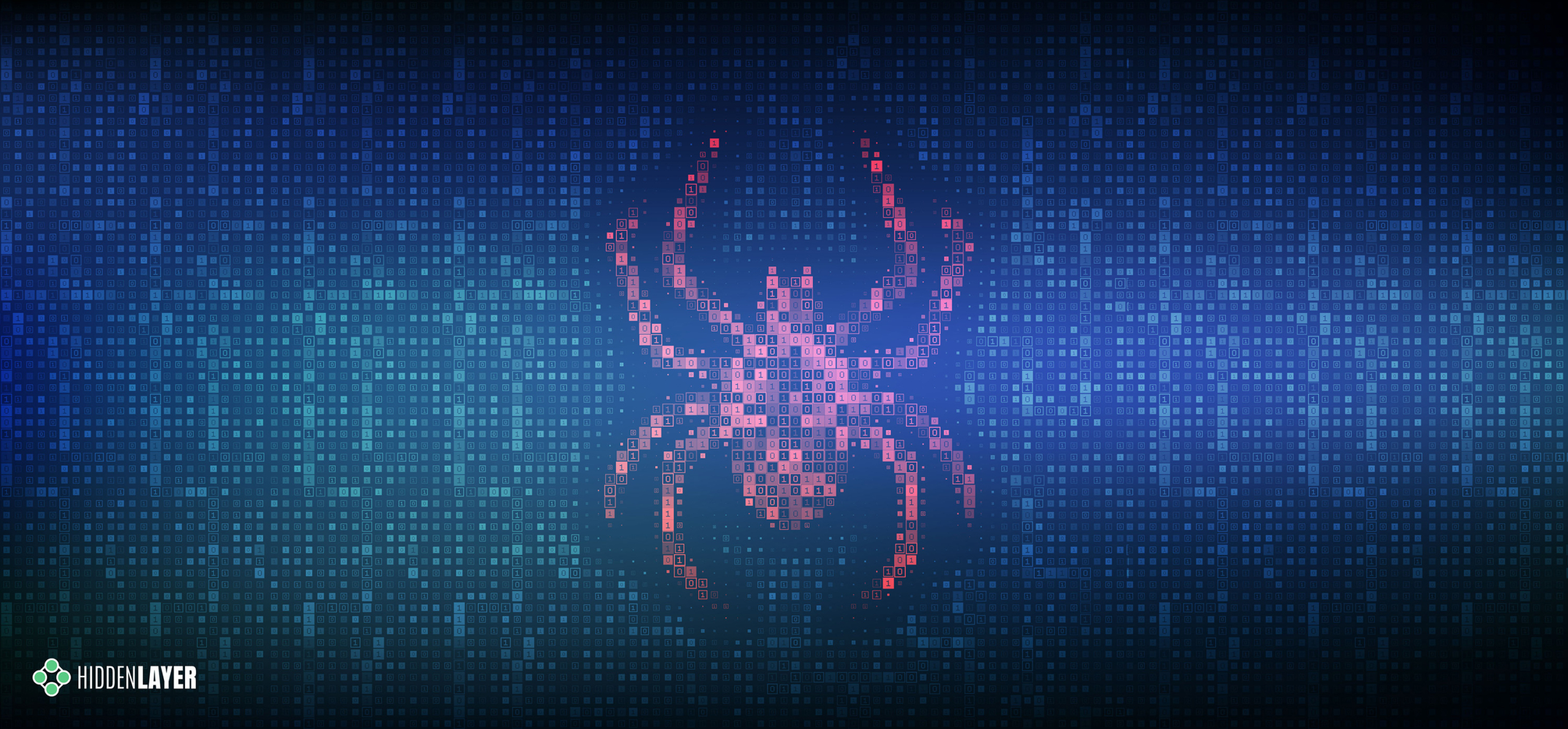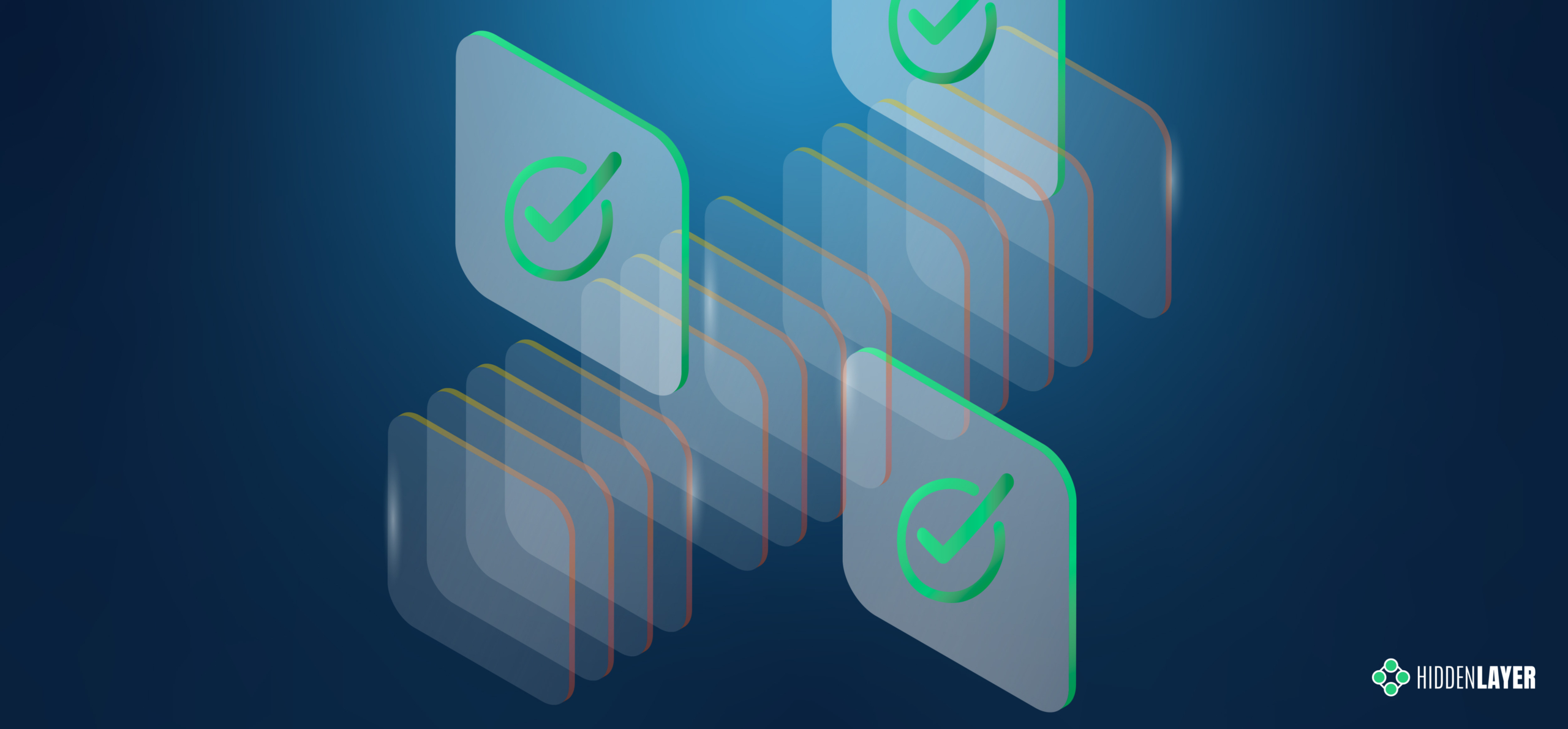Summary
HiddenLayer researchers have discovered a vulnerability, CVE-2024-27322, in the R programming language that allows for arbitrary code execution by deserializing untrusted data. This vulnerability can be exploited through the loading of RDS (R Data Serialization) files or R packages, which are often shared between developers and data scientists. An attacker can create malicious RDS files or R packages containing embedded arbitrary R code that executes on the victim’s target device upon interaction.
Introduction
What is R?
R is an open-source programming language and software environment for statistical computing, data visualization, and machine learning. Consisting of a strong core language and an extensive list of libraries for additional functionality, it is only natural that R is popular and widely used today, often being the only programming language that statistics students learn in school. As a result, the R language holds a significant share in industries such as healthcare, finance, and government, each employing it for its prowess in performing statistical analysis in large datasets. Due to its usage with large datasets, R has also become increasingly popular in the AI/ML field.
To further underscore R’s pervasiveness, many R conferences are hosted around the world, such as the R Gov Conference, which features speakers from major organizations such as NASA, the World Health Organization (WHO), the US Food and Drug Administration (FDA), the US Army, and so on. R’s use within the biomedical field is also very established, with pharmaceutical giants like Pfizer and Merck & Co. actively speaking about R at similar conferences.
R has a dedicated following even in the open-source community, with projects like Bioconductor being referenced in their documentation, boasting over 42 million downloads and 18,999 active support site members last year. R users love R – which is even more evident when we consider the R equivalent to Python’s PyPI – CRAN.
The Comprehensive R Archive Network (CRAN) repository hosts over 20,000 packages to date. The R-project website also links to the project repository R-forge, which claims to host over 2,000 projects with over 15,000 registered users at the time of writing.
All of this is to say that the exploitation of a code execution vulnerability in R can have far-reaching implications across multiple verticals, including but not limited to vital government agencies, medical, and financial institutions.
So, how does an attack on R work? To understand this, we have to look at the R Data Serialization process, or RDS, for short.
What is RDS?
Before explaining what RDS is in relation to R, we will first give a brief overview of data serialization. Serialization is the process of converting a data structure or object into a format that can be stored locally or transferred over a network. Conversely, serialized objects can be reconstructed (deserialized) for use as and when needed. As HiddenLayer’s SAI team has previously written about, the serialization and deserialization of data can often be vulnerable to exploitation when callable objects are involved in the process.
R has a serialization format of its own whereby a user can serialize an object using saveRDS and deserialize it using readRDS. It’s worth mentioning that this format is also leveraged when R packages are saved and loaded. When a package is compiled, a .rdb file containing serialized representations of objects to be included is created. The .rdb file is accompanied by a .rdx file containing metadata relating to the binary blobs now stored in the .rdb file. When the package is loaded, R uses the .rdx index file to locate the data stored in the .rdb file and load it into RDS format.
Multiple functions within R can be used to serialize and deserialize data, which slightly differ from each other but ultimately leverage the same internal code. For example, the serialize() function works slightly differently from the saveRDS() function, and the same is true for their counterpart functions: unserialize() and readRDS(); as you will see later, both of these work their way through to the same internal function for deserializing the data.
Vulnerability Overview
Our team discovered that it is possible to craft a malicious RDS file that will execute arbitrary code when loaded and referenced. This vulnerability, assigned CVE-2024-27322, involves the use of promise objects and lazy evaluation in R.
R’s Interpreted Serialization Format
As we mentioned earlier, several functions and code paths lead to an RDS file or blob getting deserialized. However, regardless of where that request originated, it eventually leads to the R_Unserialize function inside of serialize.c, which is what our team honed in on. Like most other formats, RDS contains a header, which is the first component parsed by the R_Unserialize function.
The header for an RDS binary blob contains five main components:
- the file format
- the version of the file
- the R version that was used to serialize the blob
- the minimum R version needed to read the blob
- depending on the version number, a string representing the native encoding.
RDS files can be either an ASCII format, a binary format, or an XDR format, with the XDR format being the most prevalent. Each has its own magic numbers, which, while only needing one byte, are stored in two bytes; however, due to an issue with the ASCII format, files can sometimes have a magic number of three bytes in the header. After reading the two – or sometimes three – byte magic number for the format, the R_Unserialize function reads the other header items, which are each considered an integer (4 bytes for both the XDR and binary formats and up to 127 bytes for the ASCII format). If the file version is 2, no header checks are performed. If the file version is 3, then the function reads another integer, checks its size, and then reads a string of the length into the native_encoding variable, which is set to ‘UTF-8’ by default. If the version is neither 2 nor 3, then the writer version and minimum reader versions are checked. Once the header has been read and validated, the function tries to read an item from the blob.
The RDS format is interesting because while consisting of bytecode that gets parsed and run in the interpreter inside the ReadItem function, the instructions do not include a halt, stop, or return command. The deserialization function will only ever return one object, and once that object has been read, the parsing will end. This means that one technical challenge for an exploit is that it needs to fit naturally into an existing object type and cannot be inserted before or after the returned object. However, despite this limitation, almost all objects in the R language can be serialized and deserialized using RDS due to attributes, tags, and nested values through the internal CAR and CDR structures.
The RDS interpreter contains 36 possible bytecode instructions in the ReadItem function, with several additional instructions becoming available when used in relation to one of the main instructions. RDS instructions all have different lengths based on what they do; however, they all start with one integer that is encoded with the instruction and all of the flags through bit masking.
The Promise of an Exploit
After spending some time perusing the deserialization code, we found a few functions that seemed questionable but did not have an actual vulnerability, that is, until we came across an instruction that created the promise object. To understand the promise object, we need to first understand lazy evaluation. Lazy evaluation is a strategy that allows for symbols to be evaluated only when needed, i.e., when they are accessed. One such example is the delayedAssign function that allows a variable to be assigned once it has been accessed:
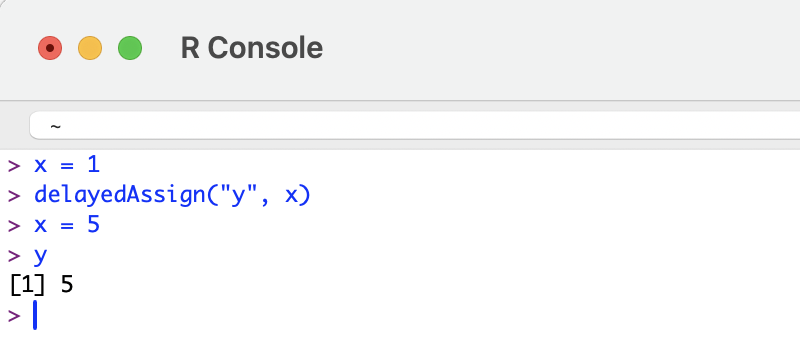
Figure 1: DelayedAssign Function
The above is achieved by creating a promise object that has both a symbol and an expression attached to it. Once the symbol ‘y’ is accessed, the expression assigning the value of ‘x’ to ‘y’ is run. The key here is that ‘y’ is not assigned the value 1 because ‘y’ is not assigned to ‘x’ until it is accessed. While we were not successful in gaining code execution within the deserialization code itself, we thought that since we could create all of the needed objects, it might be possible to create a promise that would be evaluated once someone tried to use whatever had been deserialized.
The Unbounded Promise
After some research, we found that if we created a promise where instead of setting a symbol, we set an unbounded value, we could create a payload that would run the expression when the promise was accessed:
Opcode(TYPES.PROMSXP, 0, False, False, False,None,False),
Opcode(TYPES.UNBOUNDVALUE_SXP, 0, False, False, False,None,False),
Opcode(TYPES.LANGSXP, 0, False, False, False,None,False),
Opcode(TYPES.SYMSXP, 0, False, False, False,None,False),
Opcode(TYPES.CHARSXP, 64, False, False, False,"system",False),
Opcode(TYPES.LISTSXP, 0, False, False, False,None,False),
Opcode(TYPES.STRSXP, 0, False, False, False,1,False),
Opcode(TYPES.CHARSXP, 64, False, False, False,'echo "pwned by HiddenLayer"',False),
Opcode(TYPES.NILVALUE_SXP, 0, False, False, False,None,False),Once the malicious file has been created and loaded by R, the exploit will run no matter how the variable is referenced:
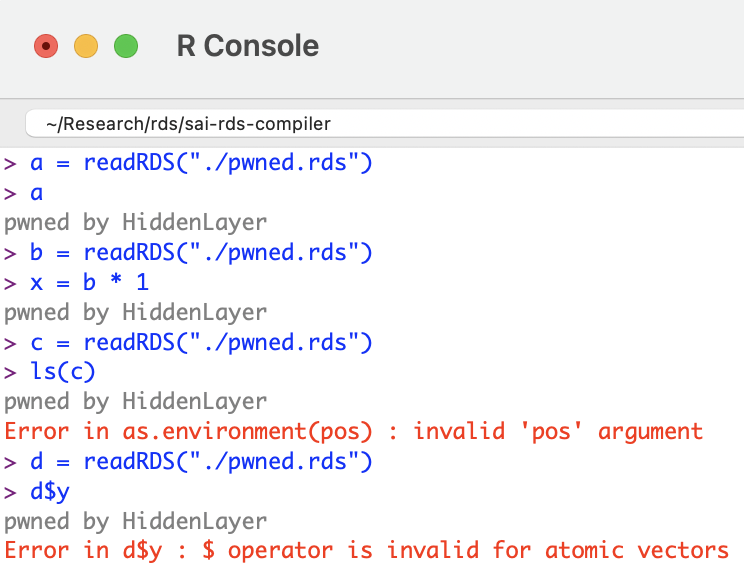
Figure 2: readRDS Exploited
R Supply Chain Attacks
ShaRing Objects
After searching GitHub, our team discovered that readRDS, one of the many ways this vulnerability can be exploited, is referenced in over 135,000 R source files. Looking through the repositories, we found that a large amount of the usage was on untrusted, user-provided data, which could lead to a full compromise of the system running the program. Some source files containing potentially vulnerable code included projects from R Studio, Facebook, Google, Microsoft, AWS, and other major software vendors.
R Packages
R packages allow for the sharing of compiled R code and data that can be leveraged by others in their statistical tasks. As previously mentioned, at the time of writing, the CRAN package repository claims to feature 20,681 available packages. Packages can be uploaded to this repository by anybody; there are criteria a package must fulfill in order to be accepted, such as the fact that the package must contain certain files (such as a description) and must pass certain automated checks (which do not check for this vulnerability).
To recap, R packages leverage the RDS format to save and load data. When a package is compiled, two files are created that facilitate this:
- .rdb file: objects to be included within the package are serialized into this file as binary blobs of data;
- .rdx file: contains metadata associated with each serialized object within the .rbd file, including their offsets.
When a package is loaded, the metadata stored in the RDS format within the .rdx file is used to locate the objects within the .rdb file. These objects are then decompressed and deserialized, essentially loading them as RDS files.
This means R packages are vulnerable to the deserialization vulnerability and can, therefore, be used as part of a supply chain attack via package repositories. For an attacker to take over an R package, all they need to do is overwrite the .rdx file with the maliciously crafted file, and when the package is loaded, it will automatically execute the code:
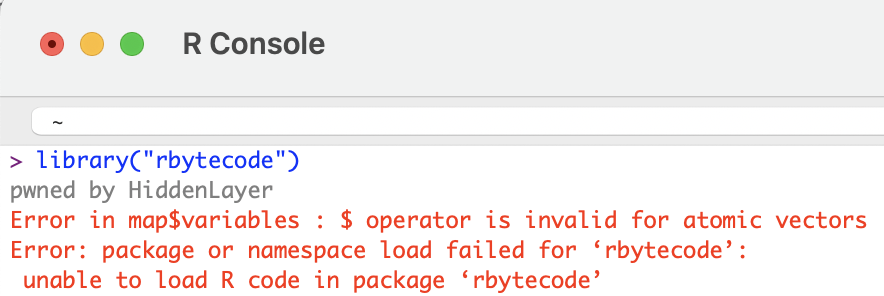
If one of the main system packages, such as compiler, has been modified, then the malicious code will run when R is initialized.
Conclusion
R is an open-source statistical programming language used across multiple critical sectors for statistical computing tasks and machine learning. Its package building and sharing capabilities make it flexible and community-driven. However, a drawback to this is that not enough scrutiny is being placed on packages being uploaded to repositories, leaving users vulnerable to supply chain attacks.
In the context of adversarial AI, such vulnerabilities could be leveraged to manipulate the integrity of machine learning models or exploit weaknesses in AI systems. To combat such risks, integrating an AI security framework that includes robust defenses against adversarial AI techniques is critical to safeguarding both the software and the larger machine learning ecosystem.
R’s serialization and deserialization process, which is used in the process of creating and loading RDS files and packages, has an arbitrary code execution vulnerability. An attacker can exploit this by crafting a file in RDS format that contains a promise instruction setting the value to unbound_value and the expression to contain arbitrary code. Due to lazy evaluation, the expression will only be evaluated and run when the symbol associated with the RDS file is accessed. Therefore if this is simply an RDS file, when a user assigns it a symbol (variable) in order to work with it, the arbitrary code will be executed when the user references that symbol. If the object is compiled within an R package, the package can be added to an R repository such as CRAN, and the expression will be evaluated and the arbitrary code run when a user loads that package.
Given the widespread usage of R and the readRDS function, the implications of this are far-reaching. Having followed our responsible disclosure process, we have worked closely with the team at R who have worked quickly to patch this vulnerability within the most recent release – R v4.4.0. In addition, HiddenLayer’s AISec Platform will provide additional protection from this vulnerability in its Q2 product release.
